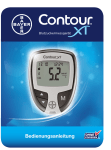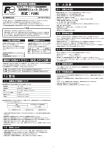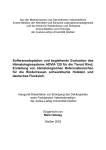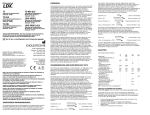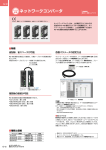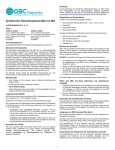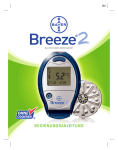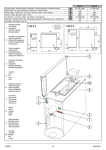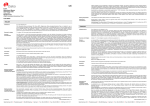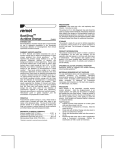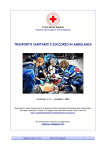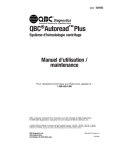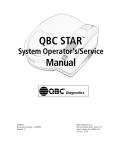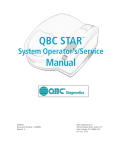Download QBC® STAR Tube - Drucker Diagnostics
Transcript
QBC STAR Tube ® English: Français: Deutsch: pages pages Seiten 1– 4 5– 8 8– 11 Italiano: Español: pagine páginas 11 – 15 – L-001078 Rev. D 14 18 U.S. Patent Numbers: 6,002,474; 6,074,883; 6,080,366. Kontakt venligst den lokale QBC-repræsentant for at bestille instrukser på dansk. Contacte o seu representante local da QBC para obter as instruções de utilização em português. Kontakta närmaste QBC-representant för att erhålla instruktioner på svenska. INTENDED USE STAR Tubes are used with the QBC STAR™ analyzer to provide a diagnostic hematology profile. Venous or capillary blood can be tested. The following quantitative values are obtained from a single STAR tube: Hematocrit, hemoglobin, mean corpuscular hemoglobin concentration (MCHC), platelet count, white blood cell count, granulocyte count (% and number), and lymphocyte/monocyte count (% and number). PRINCIPLES OF THE PROCEDURE When a tube of blood is placed in a centrifuge and spun, the different types of cells in the blood separate into layers from the heaviest to the lightest. A special coating in the STAR tube stains the different cell layers. These layers are made larger by a plastic float inside the tube. The QBC STAR analyzer measures the cell layers and converts the measurements into reported values.1,2,3 SUMMARY AND EXPLANATION The QBC STAR instrument is a small, portable, table top centrifugal hematology analyzer. The instrument uses specially designed tubes known as the STAR Tube. Each tube has two black fill lines, a white line, reagents and a cap. The tube is filled by capillary action with 70 µL of either anticoagulated venous blood or capillary blood. The blood is mixed with the reagents by rocking the tube, the float is inserted as the tube is capped by placing the tube cap over the collection end of the tube. After seating the cap, the tube is placed in the analyzer for automatic processing. The QBC STAR displays and prints the results at the completion of the processing cycle. REAGENTS Each tube contains a maximum of 6.5 µg Acridine Orange, 0.65 mg Potassium Oxalate, 1.5 USP units Sodium Heparin (anticoagulant), 0.33 mg Dipotassium EDTA (anticoagulant), agglutinating agents and stabilizers. TUBE STORAGE Store in a dry cupboard or drawer, at 60 to 90ºF (16 to 32ºC). Do not store in bright light. The tubes are individually packaged in a foil-plastic blister that also contains a desiccant sachet. Do not open or remove the tube from the unitized package until needed. An expiration date is printed on the box and the unitized package. Do not use tubes that are past the expiration date. The tube must be used after opening the unitized package; do not remove the tube from the unitized package until needed. BLOOD COLLECTION AND STORAGE Refer to the QBC STAR System User’s Manual for precautions and procedures related to blood collection. STAR Tubes can be used with blood samples collected either by venipuncture (venous blood) or skin puncture (capillary blood). Venipuncture is the preferred collection method for hematology testing.4,5,6 Follow accepted practices when taking the sample.6 WARNINGS For in vitro Diagnostic Use. Acridine orange reagent may be toxic; do not ingest. Avoid contact with skin, eyes and clothing. Pathogenic microorganisms, including hepatitis viruses and Human Immunodeficiency Virus, may be present in clinical specimens. “Standard Precautions”7-10 and institutional guidelines should be followed in handling all items contaminated with blood and other body fluids. 1 STAR Tubes consist of a glass tube that extends beyond the plastic sleeve prior to capping the tube. Be careful when handling and preparing tubes to prevent breakage and possible injury. Inspect STAR Tubes before use. Do not use cracked or broken tubes. If a tube breaks, refer to the QBC STAR System User’s Manual for guidance. PREPARATION AND TESTING Users should review the QBC STAR System User’s Manual before using these procedures. • Materials Provided: Catalog No. 429625, 100 Tube tests or Catalog No. 429011, 20 Tube tests – individually packaged, and assembled with cap, floats and instructions for use. • Materials Required But Not Provided: QBC STAR Instrument. SAMPLE STORAGE AND TIMING Venous blood samples may be stored at room temperatures 68 to 77ºF (20 to 25ºC) for up to 8 h prior to preparation of STAR Tubes. Samples that cannot be tested immediately must be refrigerated if the room temperature is above 77ºF (25ºC). Refrigerated samples stored at 36 to 46ºF (2 to 8ºC) are stable for up to 8 h. Bring sample back to room temperature before you prepare a STAR Tube. The tube should be placed in the QBC STAR analyzer promptly after filling with blood and capping, and no later than 15 min after filling with blood. • Pre-Test Conditions Tests must be run at room temperature [68 to 98ºF (20 to 37ºC)] The QBC STAR analyzer must be turned on and have passed the system self test before processing samples. Refer to the Operator’s Manual for analyzer start-up and quality control procedures. RUNNING A PATIENT SAMPLE STEP 1: FILL THE TUBE NOTE: Refer to QBC STAR Quick Reference Guide for illustrations of these steps. ANTICOAGULATED VENOUS BLOOD Gently mix the sample at least 12 – 15 times by inversion before filling the tube. Tilt the sample vial, and place the collection tip of the STAR Tube in contact with the blood tube. Do not allow the plastic sleeve to contact the blood. Fill the tube beyond the first black line and up to the second black line. CAPILLARY BLOOD Place the collection tip of the STAR Tube in contact with the blood droplet at the finger puncture site. Do not allow the plastic sleeve to contact the blood. Fill the tube beyond the first black line and up to the second black line. ROCK THE TUBE TO MIX NOTE: Do not allow the blood to touch the tube plug while performing this step. If blood stops mixing, discard tube and fill a new tube. Rock the tube back and forth at least 4 times to mix the blood with the orange coating. For each complete rock, allow the blood to move from the open end to the bottom (plug) end and back to the open end. Hold the tube at an angle allowing the blood to move down the tube towards the center of the tube. STEP 2: STEP 3: CAP THE TUBE Remove the cap from the tube by pulling the cap straight off the bottom of the tube. Place the cap over the collection end of the tube by guiding the glass end of the tube into the center of the cap. Push the cap on firmly. READ THE TUBE Promptly insert the tube into the QBC STAR analyzer oriented with the top of the tube (capped end) pointing into the analyzer. 2 Close the analyzer door. Press the “start” button. When the test is complete, the results are automatically displayed and printed. DO NOT OPEN THE ANALYZER DOOR UNTIL THE RESULTS ARE REVIEWED AND PRINTED. Test results are cleared from the display when the analyzer door is opened. Open the analyzer door and remove the sample. Discard the STAR Tube in a biohazard container. TECHNICAL INFORMATION See the QBC STAR System User’s Manual for information concerning accuracy, precision and operating range of QBC STAR hematology tests. INTERFERING SUBSTANCES Hemolysis: Do not perform tests on visibly hemolyzed blood specimens. Bilirubin: No effects on test results have been observed at bilirubin concentrations up to 20 mg/dL.11 Triglycerides: No effects on test results have been observed at triglycerides concentrations up to 1,800 mg/dL.11 Coumadin: Anticoagulant therapy has been shown to have no clinically significant effect on performance.11 Doxorubicin: Treatment with the anthracyclic drug Doxorubicin does not appear to interfere with the QBC™ test method.11 Other drugs: The effects of other potentially interfering drugs and their metabolites on QBC tests have not been established.12,13 QUALITY CONTROL Instrument performance is checked automatically, during every sample run, by a series of electronic, optical and mechanical measurements. Blood sample results are only displayed if all electronic quality control measurements pass factory set limits. Successful quality checks are documented on the printout with sample results. See the QBC STAR Instrument Operator’s Manual for further information concerning analyzer start-up and quality control procedures. LIMITATIONS Quality medical care requires that laboratory values be correlated with each patient’s symptoms and signs by a trained practitioner. The Performance section of the QBC STAR System User’s Manual lists the validated upper and lower limits of the operating range. Values above and below these validated ranges are not printed or displayed by the analyzer and such samples must be tested by an alternate method. The tube has been formulated to provide optimum packing and layering of normal cells. In small numbers of patients, however, the instrument cannot read certain parameters, and will not report a value. User errors in processing or use of outdated or inappropriately stored tubes can also result in non-reported results. Practitioners must not assume that unreported values are normal; further testing with an alternative method is essential. Automated granulocyte and lymphocyte/monocyte differential counts cannot replace the conventional manual differential. Due to the grouping by density of the cell populations by the QBC test method, the instrument cannot discriminate between normal and abnormal cell types in disease states characterized by the presence of abnormal white cell types or nucleated red blood cells. If abnormal cell populations are suspected, verification of QBC test results or testing and diagnosis by alternative methods is essential. The combined lymphocyte/monocyte count should not be used to test for lymphocytopenia in evaluating patients with known or possible immunodeficiencies. Further evaluation of lymphocyte/ monocyte counts in relevant situations must include a manual differential and lymphocyte subset analysis. 3 The presence of abnormally sized platelets may lead to discrepancies between the QBC test method platelet count, which is based on platelet mass, and results obtained with an impedance counter, which are based on measurement of particle number. AVAILABILITY Cat. No.Description 429011 QBC STAR™ 20 STAR Tubes 429625 QBC STAR™ 100 STAR Tubes REFERENCES 1. Wardlaw, S.C. and Levine, R.A.: Quantitative Buffy Coat Analysis: JAMA (1983); 5:617-620. 2. Zucker, R.M. and Casse, B. (1966) The Separation of Normal Human Leukocytes by Density and Classification by Size; Blood, 34:5, 591-600. 3. Jackson, J.F. (1961): Supravital Blood Studies, Using Acridine Orange Fluorescence; Blood, 172643-649. 4. Koepke, John A., (1991): Specimen Collection for Cellular Hematology; In Practical Laboratory Hematology, Koepke, John A. (Ed.) Churchill Livingstone, New York, pp. 33-35. 5. Nelson, Douglas A. and Morris, Michael W. (1984): Basic Methodology, In Clinical Diagnosis and Management by Laboratory Methods, Henry, John B. (Ed.) 17 Edition, W.B. Saunders Company, Philadelphia, pp. 578-579. 6. National Committee for Clinical Laboratory Standards. Procedures for the Collection of Diagnostic Blood Specimens by Skin Puncture; Approved Standard (1991) NCCLS document H4-A3 Villanova, Pennsylvania 19085. 7. National Committee for Clinical Laboratory Standards. 1997. Approved Guideline M29-A. Protection of laboratory workers from instrument biohazards and infectious disease transmitted by blood, body fluids and tissue. NCCLS, Wayne, Pa. 8. Garner, J.S. 1996. Hospital Infection Control Practices Advisory Committee, U.S. Department of Health and Human Services, Centers for Disease Control and Prevention. Guideline for isolation precautions in hospitals. Infect. Control Hospital Epidemiol. 17:53-80 9.U.S. Department of Health and Human Services. 1999. Biosafety in microbiological and biomedical laboratories, HHS Publication (CDC), 4th ed. U.S. Government Printing Office, Washington, D.C. 10. Directive 2000/54/EC of the European Parliament and of the Council of 18 September 2000 on the protection of workers from risks related to exposure to biological agents at work (seventh individual directive within the meaning of Article 16(1) of Directive 89/391/EEC). Official Journal L262, 17/10/2000, p. 0021-0045. 11. Data on file at QBC Diagnostics , Philipsburg, PA 16866. 12. Yount, D.S., Pestaner, L.C. and Gibberman, V. (1975): Effects of Drugs on Clinical Laboratory Tests; Clin, Chem., 21, 313D, 345D, 346D, 390D, 391D, 392D. 13. Elking, M.P. and Kabat, H. (1968) “Drug Induced Modifications of Laboratory Test Values,” Am. J. Hosp. Pharm., 25, 485. QBC, QBC Logo and QBC Diagnostics are trademarks of QBC Diagnostics, Inc. © 2004 QBC Diagnostics, Inc. 4 QBC® Tube STAR Français APPLICATION Les Tubes STAR sont utilisés avec l’analyseur QBC STAR en vue de fournir un profil hématologique pour le diagnostic. Du sang capillaire ou veineux peut être utilisé pour le test. Les valeurs quantitatives suivantes sont obtenues à partir d’un seul Tube STAR : hématocrite, hémoglobine, concentration corpusculaire moyenne en hémoglobine (CCMH), numération des plaquettes, numération des globules blancs, numération des granulocytes (% et nombre) et numération des lymphocytes/monocytes (% et nombre). PRINCIPES DE LA METHODE Quand un tube de sang est placé dans un centrifugeur et est centrifugé, les différents types de cellules sanguines se déposent en couches allant de la plus lourde à la plus légère. Un revêtement spécial dans le Tube STAR colore les différentes couches cellulaires. Ces couches sont agrandies par un flotteur plastique à l’intérieur du tube. L’analyseur QBC STAR mesure la hauteur des couches cellulaires et convertit ces mesures dans les valeurs rapportées.1,2,3 RESUME ET EXPLICATION L’instrument QBC STAR consiste en un petit analyseur centrifugeur, portable, de table, pour l’héma tologie. L’instrument utilise des tubes spécialement conçus qui sont désignés par l’appellation Tubes STAR. Chaque tube possède deux lignes noires de remplissage, une ligne blanche, des réactifs et un capuchon. Le tube est rempli par capillarité avec 70 µL soit de sang veineux anticoagulé soit de sang capillaire. Le sang est mélangé avec les réactifs en agitant le tube, le flotteur est introduit de facto lors de la fermeture du tube avec le capuchon lorsque le capuchon est posé sur l’extrémité prélevante du tube. Une fois le capuchon posé, le tube est placé dans l’analyseur pour une analyse automatique. L’instrument QBC STAR affiche et imprime les résultats à la fin du cycle d’analyse. REACTIFS Chaque tube contient un maximum de 6,5 µg d’orangé d’acridine, 0,65 mg d’oxalate de potassium, 1,5 unités USP d’héparine, sel de sodium (anticoagulant), 0,33 mg EDTA , sel dipotassique (anticoagulant), des agents agglutinants et stabilisants. CONSERVATION DES TUBES Conserver dans un placard ou un tiroir sec à 16 – 32 ºC. Ne pas la conserver en lumière vive. Les tubes sont emballés individuellement dans une pochette en aluminium et plastique qui contient aussi un agent desséchant. Ne pas ouvrir la poche individuelle ni en retirer le tube tant qu’on n’a pas besoin du tube. Une date de péremption est imprimée sur la boîte et la pochette individuelle. Ne pas utiliser les tubes dont la date de péremption est dépassée. Le tube doit être utilisé dès que la pochette individuelle a été ouverte ; ne pas retirer un tube de sa pochette individuelle tant qu’on en n’a pas besoin. PRELEVEMENT ET CONSERVATION DU SANG Consulter le manuel de l’utilisateur du système QBC STAR pour les précautions à prendre et les procédures à suivre pour le prélèvement du sang. Les Tubes STAR peuvent servir pour les échantillons de sang prélevés soit par ponction veineuse (sang veineux) soit par ponction cutanée (sang capillaire). La ponction veineuse est la méthode de prélèvement préférée pour l’analyse hématologique.4,5,6 Suivre les pratiques en vigueur lors du prélèvement des échantillons.6 AVERTISSEMENTS Réservé au diagnostic in vitro. L’orangé d’acridine peut être toxique, ne pas l’ingérer. Eviter tout contact avec la peau, les yeux et les vêtements. Des microorganismes pathogènes, notamment les virus de l’hépatite et de l’immunodéficience humaine, sont susceptibles d’être présents dans les échantillons cliniques. Respecter les 5 « Précautions standard »7-10 et les consignes en vigueur dans l’établissement pour manipuler tout objet contaminé avec du sang ou d’autres liquides organiques. Les Tubes STAR sont composés d’un tube en verre qui dépasse le manchon en plastique avant la pose du capuchon sur le tube. Faire attention lors de la manipulation et la préparation des tubes pour éviter toute cassure du tube et blessure potentielle. Inspecter les Tubes STAR avant de les utiliser. Ne pas utiliser des tubes fêlés ou cassés. Si un tube casse, consulter le manuel de l’utilisateur du système QBC STAR pour des directives. PREPARATION ET ANALYSE Les utilisateurs doivent étudier le manuel de l’utilisateur du système QBC STAR avant d’utiliser ces procédures. • Matériel fourni : No. de catalogue 429625, 100 tubes d’analyse ou No. de catalogue 429011, 20 tubes d’analyse – emballés individuellement et fournis avec capuchon, flotteur et mode d’emploi. • Matériel requis mais non fourni: Instrument QBC STAR. CONSERVATION DES ECHANTILLONS ET MINUTAGE Les échantillons de sang veineux peuvent être conservés à température ambiante 20 – 25 ºC pendant au plus 8 h avant la préparation des Tubes STAR. Les échantillons qui ne peuvent pas être analysés immédiatement doivent être conservés au réfrigérateur si la température ambiante est supérieure à 25 ºC. Les échantillons réfrigérés à 2 – 8 ºC restent stables pendant au plus 8 h. Ramener les échantillons à la température ambiante avant de préparer un Tube STAR. Le tube doit être placé sans tarder dans l’analyseur QBC STAR après avoir été rempli de sang et bouché, à savoir pas plus de 15 min après avoir été rempli de sang. • Conditions avant-analyse Les analyses doivent être effectuées à température ambiante 20 – 37 ºC. L’analyseur QBC STAR doit être allumé et avoir réussi le test d’auto-contrôle du système avant d’analyser les échantillons. Consulter le manuel de l’utilisateur pour connaître les procédures de démarrage et de contrôle de la qualité. ANALYSER UN ECHANTILLON DE PATIENT ETAPE 1 : REMPLIR LE TUBE NOTA : Consulter le manuel de référence rapide QBC STAR pour une illustration de ces étapes. SANG VEINEUX ANTICOAGULÉ Mélanger doucement l’échantillon en le retournant au moins 12 –- 15 fois avant de remplir le tube. Pencher le flacon de l’échantillon et placer l’extrémité prélevante du Tube STAR en contact avec le flacon de sang. Ne pas permettre au manchon en plastique de toucher le sang. Remplir le tube en dépassant la première ligne noire et en allant jusqu’à la seconde ligne noire. SANG CAPILLAIRE Placer l’extrémité prélevante du Tube STAR en contact avec la gouttelette de sang sur le site de la piqûre au doigt. Ne pas permettre au manchon en plastique de toucher le sang. Remplir le tube en dépassant la première ligne noire et en allant jusqu’à la seconde ligne noire. AGITER LE TUBE POUR LE MÉLANGER NOTA : Ne pas permettre au sang d’entrer en contact avec le bouchon du tube pendant l’exécution de cette étape. Si le sang bloque l’agitation, jeter le tube et remplir un nouveau tube. Agiter le tube d’avant en arrière au moins 4 fois pour mélanger le sang avec le revêtement orange. Pour chaque mouvement complet de va et vient, laisser le sang aller de l’extrémité ouverte du tube au fond du tube (extrémité avec bouchon) et revenir à l’extrémité ouverte. 6 Maintenir le tube penché de façon à permettre au sang de descendre le long du tube vers le centre du tube. ETAPE 2 : METTRE LE CAPUCHON SUR LE TUBE Retirer le capuchon du tube en tirant tout droit le capuchon hors du fond du tube. Placer le capuchon sur l’extrémité prélevante du tube en guidant l’extrémité en verre du tube dans le centre du capuchon. Bien enfoncer le capuchon. ETAPE 3 : LIRE LE TUBE Introduire promptement le tube dans l’analyseur QBC STAR, le haut du tube (extrémité capuchonnée) pointant vers l’intérieur de l’analyseur. Fermer la porte de l’analyseur. Appuyer sur le bouton « start ». Lorsque l’analyse est terminée, les résultats sont automatiquement affichés et imprimés. NE PAS OUVRIR LA PORTE DE L’ANALYSEUR TANT QUE LES RESULTATS N’ONT PAS ETE EXAMINES ET IMPRIMES. L’affichage des résultats de l’analyse disparaît dès que la porte de l’analyseur est ouverte. Ouvrir la porte de l’analyseur et sortir l’échantillon. Jeter le Tube STAR dans un récipient pour déchets présentant un risque biologique. INFORMATION TECHNIQUE Voir le manuel de l’utilisateur du système QBC STAR pour des informations concernant la précision, l’exactitude et la plage analytique des analyses hématologiques QBC STAR. SUBSTANCES INTERFÉRENTES Hémolyse : Ne pas effectuer les analyses sur des échantillons de sang visiblement hémolysés. Bilirubine : Aucun effet sur les résultats des analyses n’a été observé pour des concentrations de bilirubine s’élevant jusqu’à 20 mg/dL.11 Triglycérides : Aucun effet sur les résultats des analyses n’a été observé pour des concentrations de triglycérides s’élevant jusqu’à 1.800 mg/dL.11 Coumadine : Il a été montré que le traitement anticoagulant n’avait aucun effet clinique significatif sur la performance.11 Doxorubicine : Le traitement avec l’anthracycline, doxorubicine, ne paraît pas affecter la méthode d’analyse QBC.11 Autres médicaments : Les effets des autres médicaments et de leurs métabolites pouvant potentiellement affecter les analyses QBC n’ont pas été déterminés.12,13 CONTROLE DE QUALITE La performance de l’instrument est contrôlée automatiquement pendant chaque cycle d’analyse par une série de mesures électroniques, optiques et mécaniques. Les résultats des échantillons sanguins sont seulement affichés si toutes les mesures de contrôle de la qualité électroniques satisfont aux limites établies en usine. Les contrôles de qualité réussis sont donnés sur l’imprimé des résultats de l’échantillon. Voir le manuel de l’utilisateur de l’instrument QBC STAR pour des informations complémentaires concernant les procédures de mise en route et de contrôle de la qualité de l’analyseur. LIMITES Des soins médicaux de qualité nécessitent que les valeurs obtenues en laboratoire soient corrélées avec les symptômes et signes cliniques de chaque patient par un praticien qualifié. La section Performance du manuel de l’utilisateur du système QBC STAR donne les limites supérieure et inférieure valides de la plage analytique. Toute valeur en dehors de cette plage analytique valide est ni imprimée ni affichée par l’analyseur et les échantillons correspondants doivent être analysés par une autre méthode. Le tube a été formulé pour fournir une sédimentation et un entassement optimum des cellules normales. Pour un petit nombre de patients, néanmoins, l’instrument ne peut pas lire certains paramètres et ne fournira pas de valeurs. Les erreurs utilisateurs pendant l’analyse ou l’emploi de tubes périmés ou 7 conservés de façon inadéquate peuvent aussi se traduire par l’absence de rapport des résultats. Les praticiens ne doivent pas supposer que les valeurs non rapportées sont normales ; des analyses par d’autres méthodes sont absolument nécessaires. La numération différentielle automatique des granulocytes et des lymphocytes/monocytes ne peut pas remplacer la méthode de numération traditionnelle manuelle. En raison du regroupement selon la densité des populations cellulaires par la méthode d’analyse QBC, l’instrument ne peut pas faire la différence entre des types normaux et anormaux de cellules dans des maladies caractérisées par la présence de types anormaux de globules blancs ou de globules rouges nucléés. Si des populations de cellules anormales sont soupçonnées, il est indispensable de confirmer les résultats de l’analyse QBC ou d’employer d’autres méthodes d’analyse et de diagnostic. La numération combinée des lymphocytes/monocytes ne doit pas servir de test pour la lymphopénie chez des patients ayant des immunodéficiences connues ou potentielles. Des évaluations supplémentaires de la numération des lymphocytes/monocytes lorsque nécessaires doivent inclure une numération manuelle et une analyse des seuls lymphocytes. La présence de plaquettes de taille anormale peut entraîner des divergences entre la numération des plaquettes par la méthode d’analyse QBC qui est fondée sur la masse des plaquettes, et les résultats provenant d’une numération basée sur l’impédance qui mesure le nombre de particules. CONDITIONNEMENT Réf.Description 429011 QBC STAR – 20 Tubes STAR 429625 QBC STAR – 100 Tubes STAR BIBLIOGRAPHIE : Voir la section « References » dans la notice en anglais. VERWENDUNGSZWECK QBC® STAR-Röhrchen Deutsch STAR-Röhrchen werden mit dem QBC STAR-Analysegerät zur Erstellung eines diagnostischen Blutbildes verwendet. Dazu kann Venen- oder Kapillarblut verwendet werden. Die folgenden quantitativen Parameter können mit einem einzigen STAR-Röhrchen bestimmt werden: Hämatokrit, Hämoglobin, MCHC (mittlere korpuskuläre Hämoglobinkonzentration), Thrombozytenzahl, Leukozytenzahl, Granulozytenzahl (prozentualer Anteil und Anzahl) und Lymphozyten-/Monozytenzahl (prozentualer Anteil und Anzahl). VERFAHRENSGRUNDLAGEN Wenn ein Röhrchen mit Blut in einer Zentrifuge geschleudert wird, trennen sich die verschiedenen Zelltypen von den schwersten zu den leichtesten Zellen in Schichten auf. Eine spezielle Beschichtung im STAR-Röhrchen färbt die verschiedenen Zellschichten. Diese Schichten werden durch einen Kunststoffschwimmer im Röhrchen vergrößert. Das QBC STAR-Analysegerät mißt die Zellschichten und rechnet die Messungen in die ausgegebenen Werte um.1,2,3 ZUSAMMENFASSUNG UND ERKLÄRUNG Das QBC STAR-Gerät ist ein kleiner, tragbarer Zentrifugal-Blutanalysator. Das Gerät wird mit speziell entworfenen Röhrchen verwendet, die als STAR-Röhrchen bezeichnet werden. Jedes Röhrchen ist mit zwei schwarzen Füllstrichen und einem weißen Strich gekennzeichnet, besitzt einen Deckel und enthält Reagenzien. Das Röhrchen wird durch kapillare Ansaugung mit 70 µL antikoaguliertem Venenblut oder mit Kapillarblut gefüllt. Das Blut wird durch Wiegebewegungen des Röhrchens mit den Reagenzien gemischt, und der Schwimmer wird beim Aufsetzen des Deckels auf der Entnahmeseite eingesetzt. Nach dem Aufsetzen des Deckels wird das Röhrchen zur automatischen Analyse in das Analysegerät eingesetzt. Die Ergebnisse werden nach dem Verarbeitungszyklus vom QBC STAR-Gerät angezeigt und ausgedruckt. REAGENZIEN Jedes Röhrchen enthält höchstens 6,5 µg Akridinorange, 0,65 mg Kaliumoxalat, 1,5 USP-Einheiten 8 Natriumheparin (Antikoagulans), 0,33 mg Dikalium-EDTA (Antikoagulans), Agglutinationsmittel und Stabilisatoren. AUFBEWAHRUNG DER RÖHRCHEN Der Karton sollte in einem trockenen Schrank oder einer Schublade bei 16 bis 32 °C und vor Licht geschützt aufbewahrt werden. Die Röhrchen sind individuell in einer Blisterpackung aus Plastikfolie mit einem Trockenmittelbeutel verpackt. Die Einheitspackungen sollten erst unmittelbar vor dem Gebrauch geöffnet werden. Das Verfallsdatum ist auf dem Karton und der Einheitspackung aufgedruckt. Die Röhrchen dürfen nach Ablauf des Verfallsdatums nicht mehr verwendet werden. Die Röhrchen müssen nach dem Öffnen der Einheitspackung verwendet werden und sollten daher erst unmittelbar vor der Verwendung entnommen werden. BLUTENTNAHME UND -AUFBEWAHRUNG Sicherheitshinweise und empfohlene Verfahren zur Blutentnahme finden Sie im Bedienerhandbuch des QBC STAR-Systems. STAR-Röhrchen können mit Blutproben verwendet werden, die mittels Venenpunktion (Venenblut) oder Lanzetteneinstich (Kapillarblut) entnommen wurden. Venenpunktion ist die bevorzugte Entnahmemethode für Blutbilder.4,5,6 Die Blutentnahme sollte in Übereinstimmung mit anerkannten Methoden erfolgen.6 WARNHINWEISE In-Vitro-Diagnostikum. Akridinorange ist potentiell giftig; nicht einnehmen. Kontakt mit Haut, Augen und Kleidung vermeiden. Klinische Proben können pathogene Mikroorganismen, wie z.B. Hepatitis-Viren und HIV, enthalten. Beim Umgang mit allen mit Blut oder anderen Körperflüssigkeiten kontaminierten Artikeln sind die „Allgemeinen Vorsichtsmaßnahmen”7-10 sowie die einschlägigen Institutionsrichtlinien zu beachten. STAR-Röhrchen bestehen aus einem Glaskörper, der vor dem Aufsetzen des Deckels über die Kunststoffhülse hinausragt. Die Röhrchen müssen vorsichtig gehandhabt und vorbereitet werden, um Brüche und potentielle Verletzungen zu vermeiden. Untersuchen Sie die STAR-Röhrchen vor der Verwendung auf Beschädigungen. Verwenden Sie keine gebrochenen oder gesprungenen Röhrchen. Anleitungen zur Vorgehensweise beim Bruch eines Röhrchens finden Sie im Bedienerhandbuch des QBC STAR-Systems. VORBEREITUNG UND TESTVERFAHREN Der Benutzer sollte vor Durchführungder der nachstehenden Verfahren das Bedienerhandbuch des QBC STAR-Systems durchlesen. • Mitgeliefertes Arbeitsmaterial: Best.-Nr. 429625, 100 Teströhrchen oder Best.-Nr. 429011, 20 Teströhrchen– individuell verpackt mit Deckel, Schwimmern und Gebrauchsanweisung. • Benötigtes, jedoch nicht mitgeliefertes Arbeitsmaterial: QBC STAR-Analysegerät. AUFBEWAHRUNG UND HALTBARKEIT DER PROBEN Venenblutproben können bei einer Raumtemperatur zwischen 20 und 25 °C bis zu 8 Std. vor der Vorbereitung der STAR-Röhrchen aufbewahrt werden. Proben, die nicht sofort getestet werden können, müssen im Kühlschrank aufbewahrt werden, wenn die Raumtemperatur über 25 °C beträgt. Im Kühlschrank bei 2 bis 8 °C aufbewahrte Proben sind bis zu 8 Std. haltbar. Vor der Vorbereitung eines STAR-Röhrchens müssen die Proben auf Raumtemperatur aufgewärmt werden. Die Röhrchen sollten sofort nach dem Füllen mit Blut und Aufsetzen des Deckels in das QBC STARAnalysegerät eingesetzt werden (höchstens 15 Min nach dem Füllen). • Vorbereitung des Tests Der Test muß bei Raumtemperatur (20 bis 37 °C) durchgeführt werden. Das QBC STAR-Analysegerät muß eingeschaltet sein und den System-Selbsttest bestanden haben, bevor Proben analysiert werden. Informationen über die Einschalt- und Qualitätskontrollverfahren des Analysegeräts finden Sie im Bedienerhandbuch. ANALYSE EINER PATIENTENPROBE SCHRITT 1:FÜLLEN SIE DAS RÖHRCHEN 9 HINWEIS: Diese Schritte sind in der QBC STAR-Kurzanleitung illustriert. ANTIKOAGULIERTES VENENBLUT Kehren Sie die Probe zum Mischen mindestens 12 – 15mal vorsichtig um, bevor Sie das Röhrchen füllen. Halten Sie das Probenröhrchen schräg, und setzen Sie die Entnahmespitze des STAR-Röhrchens am Probenröhrchen an. Die Kunststoffhülse des STAR-Röhrchens darf dabei nicht mit dem Blut in Kontakt kommen. Füllen Sie das Röhrchen über den ersten schwarzen Strich hinaus bis zum zweiten schwarzen Strich. KAPILLARBLUT Setzen Sie die Entnahmespitze des STAR-Röhrchens am Blutstropfen der Finger punktionsstelle an. Die Kunststoffhülse des STAR-Röhrchens darf dabei nicht mit dem Blut in Kontakt kommen. Füllen Sie das Röhrchen über den ersten schwarzen Strich hinaus bis zum zweiten schwarzen Strich. Wiegen Sie das Röhrchen auf und ab, um das Blut mit der Beschichtung zu mischen. HINWEIS: Das Blut darf bei diesem Schritt nicht mit dem Röhrchenstopfen in Kontakt kommen. Wenn sich das Blut nicht mischen läßt, verwerfen Sie das Röhrchen und füllen ein neues. Wiegen Sie das Röhrchen mindestens 4mal auf und ab, um das Blut mit der orangefarbenen Beschichtung zu mischen. Lassen Sie das Blut für jede komplette Wiegebewegung vom offenen Ende zum Boden (Stopfen) und wieder zurück zum offenen Ende fließen. Halten Sie das Röhrchen schräg, so daß das Blut im Röhrchen nach unten zur Mitte des Röhrchens hin fließen kann. SCHRITT 2:SETZEN SIE DEN DECKEL AUF Ziehen Sie den Deckel gerade vom Boden des Röhrchens ab. Setzen Sie den Deckel auf das Entnahmeende des Röhrchens, indem Sie das Glasende des Röhrchens in die Mitte des Deckels einführen. Drücken Sie den Deckel fest auf. SCHRITT 3: ANALYSIEREN SIE DAS RÖHRCHEN Setzen Sie das Röhrchen unverzüglich in das QBC STAR-Analysegerät ein, so daß die Spitze des Röhrchens (Deckelende) in das Innere des Analysegeräts zeigt. Schließen Sie die Tür des Analysegeräts. Drücken Sie die „Start“-Taste. Nach Durchführung des Tests werden die Ergebnisse automatisch angezeigt und ausgedruckt. ÖFFNEN SIE DIE TÜR DES ANALYSEGERÄTS ERST, NACHDEM DIE ERGEBNISSE GEPRÜFT UND AUSGEDRUCKT WORDEN SIND. Die Testergebnisse werden von der Anzeige gelöscht, wenn die Tür geöffnet wird. Öffnen Sie die Tür des Analysegeräts, und nehmen Sie die Probe heraus. Entsorgen Sie das STAR-Röhrchen in einem Behälter für infektiösen Abfall. TECHNISCHE INFORMATIONEN Informationen über Genauigkeit, Präzision und Betriebsbereiche von QBC STAR-Bluttests finden Sie im Bedienerhandbuch des QBC STAR-Systems. INTERFERIERENDE SUBSTANZEN Hämolyse: Analysieren Sie keine Blutproben mit sichtbarer Hämolyse. Bilirubin: Bilirubinkonzentrationen bis zu 20 mg/dL beeinträchtigen die Testergebnisse nicht.11 Triglyzeride: Triglyzeridkonzentrationen bis zu 1800 mg/dL beeinträchtigen die Testergebnisse nicht.11 Cumadin: Eine Therapie mit Antikoagulanzien hat keine klinisch signifikanten Auswirkungen auf die Testleistung.11 Doxorubicin: Eine Behandlung mit dem Anthracyclin-Antibiotikum Doxorubicin interferiert offenbar nicht mit 10 der QBC-Testmethode.11 Andere Arzneimittel: Die Auswirkungen anderer potentiell interferierender Arzneimittel und deren Metabolite auf QBC-Tests wurden bisher noch nicht ermittelt.12,13 QUALITÄTSKONTROLLE Die Geräteleistung wird bei jedem Probendurchlauf automatisch anhand einer Reihe von elektronischen, optischen und mechanischen Messungen geprüft. Die Ergebnisse der Blutanalyse werden nur angezeigt, wenn die elektronische Qualitätskontrolle den werkseitigen Vorgabewerten entspricht. Die Daten der bestandenen Qualitätsprüfungen werden auf dem Ausdruck mit den Probenergebnissen aufgeführt. Informationen über die Einschalt- und Qualitätskontrollverfahren des QBC STAR-Analysegeräts finden Sie im Bedienerhandbuch. VERFAHRENSBESCHRÄNKUNGEN Laborwerte müssen im Zusammenhang mit den Krankheitszeichen und-symptomen des einzelnen Patienten von einem Arzt beurteilt werden. Die gültigen oberen und unteren Betriebsgrenzen sind im Abschnitt „Leistungsdaten“ des Bediener handbuchs für das QBC STAR-System aufgelistet. Werte oberhalb oder unterhalb dieser Grenzen werden vom Gerät nicht angezeigt oder ausgedruckt, und die betreffenden Proben müssen anhand einer alternativen Methode getestet werden. Das Design des Röhrchens gewährleistet eine optimale Verdichtung und Schichtbildung normaler Zellen. Bei einer kleinen Anzahl von Patienten kann das Gerät bestimmte Parameter jedoch nicht ermitteln und zeigt keine Ergebnisse an. Bei Bedienungsfehlern oder Verwendung abgelaufener oder unsachgemäß gelagerter Röhrchen werden u. U. ebenfalls keine Ergebnisse angezeigt. Nicht berichtete Ergebnisse dürfen nicht als normale Werte interpretiert werden; die betreffenden Proben müssen anhand einer alternativen Methode getestet werden. Automatische Differentialzählungen von Granulozyten und Lymphozyten/Monozyten können das konventionelle manuelle Differentialblutbild nicht ersetzen. Da die Zellpopulationen bei der QBCTestmethode nach Dichte gruppiert werden, kann das Gerät bei Krankheiten, die durch abnorme Leukozyten oder kernhaltige Erythrozyten gekennzeichnet sind, nicht zwischen normalen und abnormen Zelltypen unterscheiden. Bei Verdacht auf abnorme Zellpopulationen müssen die QBC-Testergebnisse verifiziert oder die Proben anhand alternativer Methoden getestet werden. Die kombinierte Lymphozyten-/Monozytenzählung sollte nicht zur Untersuchung auf Lymphopenie bei Patienten mit bekannten oder potentiellen Immundefekten verwendet werden. Im gegebenen Fall muß eine Lymphozyten-/Monozytenzählung durch ein manuelles Differentialblutbild und eine Lymphozytendifferenzierung weiter abgeklärt werden. Wenn Thrombozyten abnormer Größe vorliegen, können die Ergebnisse der Thrombozytenzählung mit der QBC-Testmethode, die auf der Thrombozytenmasse basieren, von den Ergebnissen eines Zählautomaten, die auf der Anzahl der Blutkörperchen basieren, abweichen. LIEFERBARE PRODUKTE Best.-Nr.Beschreibung 429011 QBC STAR (20 STAR-Röhrchen) 429625 QBC STAR (100 STAR-Röhrchen) LITERATURNACHWEIS: Siehe den Abschnitt „References” im englischen Text. QBC® Provetta STAR Italiano USO PREVISTO Le Provette STAR sono usate insieme all’analizzatore QBC STAR per fornire un profilo emodiagnostico. È possibile testare sangue venoso o capillare. Da ogni Provetta STAR, si possono ricavare i valori quantitativi seguenti: ematocrito, emoglobina, concentrazione corpuscolare media di emoglobina (MCHC), conta delle piastrine, conta leucocitaria, conta dei granulociti (in % e numero) e conta di linfociti/monociti (in % e numero). 11 PRINCIPI DELLA PROCEDURA Allorché una provetta di sangue viene sottoposta a centrifugazione, i diversi tipi di cellule si separano differenziandosi in strati, dal più pesante al più leggero. Uno speciale rivestimento applicato sulla Provetta STAR colora i diversi strati cellulari, che vengono ingranditi da galleggianti di plastica dentro la provetta. L’analizzatore QBC STAR misura gli strati cellulari e converte le misurazioni in valori refertati.1,2,3 SOMMARIO E SPIEGAZIONE DEL METODO Lo strumento QBC STAR è un analizzatore ematologico a centrifuga, di dimensioni ridotte, portatile, da tavolo, che usa provette appositamente progettate conosciute come Provette STAR. Ogni provetta ha due righe di riempimento nere, una riga bianca, reagenti e un tappo. La provetta viene riempita mediante azione capillare di 70 µL di sangue capillare o sangue venoso anticoagulato. Il sangue si mescola con i reagenti mediante oscillazione della provetta e il galleggiante viene inserito alla chiusura della provetta ponendo su quest’ultima il tappo sull’estremità per il prelievo. Una volta sistemato il tappo, si pone la provetta nell’analizzatore per il trattamento automatico. Lo strumento QBC STAR visualizza e stampa i risultati al completamento del ciclo di trattamento. REAGENTI Ogni provetta contiene un massimo di 6,5 µg di arancio di acridina, 0,65 mg di ossalato di potassio, 1,5 unità USP di sodio eparina (anticoagulante), 0,33 mg di EDTA dipotassico (anticoagulante), agenti agglutinanti e stabilizzatori. CONSERVAZIONE DELLA PROVETTA Conservare in un cassetto o armadio asciutto, a 16 – 32 °C. Non conservare sotto luce diretta. Ciascuna provetta è confezionata in un blister in plastica-foglio d’alluminio, contenente anche un sacchetto di essiccante. Aprire o rimuovere la provetta dalla confezione unitaria soltanto al momento dell’uso. Sulla scatola e sulla confezione unitaria è riportata la data di scadenza. Non usare provette oltre la data di scadenza. Usare la provetta subito dopo l’apertura della confezione unitaria; rimuovere la provetta dalla confezione unitaria soltanto al momento dell’uso. PRELIEVO E CONSERVAZIONE DEL SANGUE Per precauzioni e procedure relative al prelievo ematico, consultare il manuale d’uso del sistema QBC STAR. Le Provette STAR possono essere usate con campioni ematici prelevati sia mediante venipuntura (sangue venoso) che puntura dermica (sangue capillare). La venipuntura è il metodo di prelievo preferito per i test ematologici.4,5,6 Per il prelievo, seguire le procedure standard.6 AVVERTENZE Per uso diagnostico in vitro. L’arancio di acridina è un reagente potenzialmente tossico; non ingerire. Evitare il contatto con occhi, cute e indumenti. I campioni clinici possono contenere microrganismi patogeni, inclusi i virus dell’epatite e il virus dell’immunodeficienza umana. Nel maneggiare qualsiasi oggetto contaminato con sangue o altri liquidi biologici, occorre attenersi alle direttive del presidio locale e alle “precauzioni standard”.7-10 Le Provette STAR consistono in una provetta di vetro che fuoriesce dal manicotto di plastica prima della chiusura della provetta. Prestare la massima attenzione durante la manipolazione e la preparazione delle provette al fine di evitare rotture e possibili lesioni. Prima dell’uso, verificare le Provette STAR. Non usare provette incrinate o rotte. In caso di rottura di una provetta, consultare il manuale del sistema QBC STAR per assistenza. PREPARAZIONE E TEST Gli utenti devono rivedere il manuale d’uso del sistema QBC STAR prima di seguire queste procedure. • Materiale fornito: n. catalogo 429625, 100 provette o n. catalogo 429011, 20 provette, confezionate individualmente e provviste di tappo, galleggianti e istruzioni per l’uso. • Materiale necessario ma non forniti: Strumento QBC STAR. CONSERVAZIONE DEI CAMPIONI E TEMPI I campioni di sangue venoso possono essere conservati a una temperatura ambiente di 20 – 25 °C per un 12 massimo di 8 ore prima della preparazione delle Provette STAR. I campioni che non possono essere testati immediatamente, devono essere refrigerati, nel caso in cui la temperatura ambiente sia superiore a 25 °C. I campioni refrigerati a 2 – 8 °C sono stabili per un massimo di 8 ore. Prima di preparare una provetta QBC STAR, riportare i campioni a temperatura ambiente. Porre la provetta nell’analizzatore QBC STAR subito dopo averla riempita di sangue e tappata e mai oltre 15 minuti da tale riempimento. • Condizioni pre-test Eseguire i test a temperatura ambiente (20 – 37 °C) Prima di trattare i campioni, accendere l’analizzatore QBC STAR e attendere che completi e superi il test automatico di sistema. Per le procedure di accensione e controllo di qualità dell’analizzatore, consultare il manuale operativo. ANALISI DI UN CAMPIONE PUNTO 1: RIEMPIMENTO DELLA PROVETTA NOTA: Per le illustrazioni di queste operazioni, consultare la guida di riferimento QBC STAR. SANGUE VENOSO ANTICOAGULATO Prima di riempire la provetta, mescolare delicatamente il campione almeno 12 – 15 volte capovolgendolo. Inclinare il flaconcino del campione e porre l’estremità di prelievo della Provetta STAR a contatto della provetta di sangue. Evitare che il manicotto di plastica venga a contatto del sangue. Riempire la provetta oltre la prima riga nera, facendo però attenzione a non superare la seconda. SANGUE CAPILLARE Porre l’estremità di prelievo della Provetta STAR a contatto della goccia di sangue sul sito di puntura sul dito. Evitare che il manicotto di plastica venga a contatto del sangue. Riempire la provetta oltre la prima riga nera, facendo però attenzione a non superare la seconda. FARE OSCILLARE LA PROVETTA PER FACILITARE LA MISCELAZIONE NOTA: durante l’esecuzione di questa operazione, evitare che il sangue tocchi il tappo della provetta. Se il sangue smette di mescolarsi, gettare la provetta e riempirne una nuova. Fare oscillare la provetta, avanti e indietro, almeno 4 volte per miscelare il sangue con il rivestimento di arancio di acridina. Al termine di ogni oscillazione completa, attendere che il sangue si porti dall’estremità aperta al fondo (tappo) e quindi di nuovo all’estremità aperta. Tenere la provetta angolata, lasciando che il sangue fluisca portandosi al centro di essa. PUNTO 2: TAPPARE LA PROVETTA Rimuovere il tappo dalla provetta togliendolo dal fondo di quest’ultima. Sistemare il tappo sull’estremità di prelievo della provetta portando l’estremità in vetro della provetta al centro del tappo. Spingere il tappo con decisione. PUNTO 3: LEGGERE LA PROVETTA Inserire velocemente la provetta nell’analizzatore QBC STAR orientata con la parte superiore (recante il tappo) rivolta all’analizzatore. Chiudere lo sportello dell’analizzatore. Premere il pulsante “start” (“avvio”). Una volta completato il test, i risultati vengano automaticamente visualizzati e stampati. NON APRIRE LO SPORTELLO DELL’ANALIZZATORE FINCHÉ I RISULTATI NON SONO STATI VISTI E STAMPATI. I risultati dei test vengono cancellati dal display all’apertura dello sportello dell’analizzatore. Aprire lo sportello dell’analizzatore e rimuovere il campione. Gettare la Provetta STAR in un 13 contenitore per rifiuti a rischio biologico. INFORMAZIONI TECNICHE Per informazioni su accuratezza, precisione e range operativo dei test ematologici QBC STAR, consultare il manuale d’uso del sistema QBC STAR. Sostanze interferenti Emolisi: non eseguire test su campioni di sangue macroscopicamente emolizzati. Bilirubina: è stato osservato che concentrazioni di bilirubina sino a 20 mg/dL non hanno effetti sui risultati dei test.11 Trigliceridi: è stato osservato che concentrazioni di trigliceridi sino a 1800 mg/dL non hanno effetti sui risultati dei test.11 Coumadin: è stato dimostrato che la terapia anticoagulante non ha effetti clinicamente significativi sulle performance.11 Doxorubicina: il trattamento con il farmaco antraciclico Doxorubicina non sembra interferire con il metodo di test QBC.11 Altri farmaci: non sono stati accertati gli effetti di altri farmaci potenzialmente interferenti e rispettivi metaboliti sui test QBC.12,13 CONTROLLO DI QUALITÀ Il funzionamento dello strumento è controllato automaticamente, durante ogni sessione di analisi dei campioni, mediante una serie di misurazioni elettroniche, ottiche e meccaniche. I risultati dei campioni ematici vengono visualizzati soltanto se tutte le misurazioni del controllo di qualità rientrano nei limiti impostati in fabbrica. I controlli di qualità superati vengono documentati sullo stampato insieme ai risultati dei campioni. Per maggiori informazioni sulle procedure di avvio e di controllo di qualità dell’analizzatore, vedere il manuale operativo dello strumento QBC STAR. LIMITAZIONI Un’assistenza medica di qualità richiede che i valori di laboratorio siano correlati a tutti i segni e sintomi del paziente da un medico esperto. La sezione Performance del manuale d’uso del sistema QBC STAR elenca i limiti superiori e inferiori validati del range operativo. I valori maggiori e minori di tali range validati non vengono stampati o visualizzati dall’analizzatore e i campioni in oggetto devono essere testati con un metodo alternativo. La provetta è stata formulata in modo da fornire pacchetto e stratificazione ottimali di cellule normali. In un numero ridotto di pazienti, lo strumento non riesce tuttavia a leggere alcuni parametri e non referta un valore. Anche errori da parte dell’utente durante il trattamento o l’uso di provette scadute o conservate erroneamente possono determinare la mancata refertazione di risultati. I medici curanti non devono presumere che i valori non riportati siano normali; sono invece essenziali altri test con un metodo alternativo. Le conte differenziali automatiche di granulociti e linfociti/monociti non possono sostituire le formule manuali convenzionali. Poiché il metodo di test QBC effettua il raggruppamento delle popolazioni cellulari per densità, lo strumento non può differenziare tra tipi di cellule normali e anormali in stati patologici caratterizzati dalla presenza di cellule leucocitarie anomale o eritrociti nucleati. In caso di sospette popolazioni cellulari anormali, è essenziale una verifica dei risultati di test QBC o un test con un metodo alternativo. La conta combinata di linfociti/monociti non deve essere usata per testare la linfocitopenia nella valutazione di pazienti con immunodeficienze accertate o possibili. Un’ulteriore valutazione delle conte di linfociti/monociti in situazioni analoghe deve comprendere una formula leucocitaria manuale e un’analisi delle sottopopolazioni linfocitarie. La presenza di piastrine di dimensioni anormali può determinare discrepanza tra la conta delle piastrine con il metodo di test QBC, che si basa sulla massa delle piastrine e i risultati ottenuti con un contatore di impedenza, basati invece sulla misurazione del numero di particelle. DISPONIBILITÀ N. di cat.Descrizione 429011 QBC STAR – 20 Provette STAR 429625 QBC STAR – 100 Provette STAR 14 BIBLIOGRAFIA: Vedere la sezione “References” nel testo inglese. USO PREVISTO Los Tubos STAR se utilizan con el analizador QBC STAR para obtener un perfil hematológico diagnóstico. Puede ser analizada sangre venosa o capilar. Se obtienen los valores cuantitativos siguientes con un QBC® Tubo STAR Español único Tubo STAR: hematocrito, hemoglobina, concentración de hemoglobina corpuscular media (CHCM), recuento de plaquetas, recuento de leucocitos, recuento de granulocitos (% y número) y recuento de linfocitos/monocitos (% y número). PRINCIPIOS DEL PROCEDIMIENTO Cuando se introduce un tubo de sangre en una centrifugadora y se le centrifugua, se separan los diferentes tipos de células sanguíneas por capas de células desde las más pesadas a las más ligeras. Un recubrimiento especial del Tubo STAR colorea las diferentes capas celulares. Estas capas son ampliadas por un flotador de plástico dentro del tubo. El analizador QBC STAR mide las capas celulares y convierte las medidas en valores informados.1,2,3 RESUMEN Y EXPLICACIÓN El instrumento QBC STAR es un pequeño analizador hematológico centrifugador que es portátil y cabe sobre una mesa. El instrumento utiliza tubos de diseño especial, conocidos como los Tubos STAR. Cada tubo tiene dos líneas negras que señalan el nivel de llenado, una línea blanca, reactivos y un tapón. El tubo se llena por acción capilar de 70 µL de sangre venosa con anticoagulante o sangre capilar. La sangre se mezcla con los reactivos agitando el tubo suavemente y el flotador se introduce al cerrar el tubo con el tapón, colocando el tapón sobre el extremo de recogida del tubo. Después de asentar bien el tapón, el tubo se introduce en el analizador para el procesamiento automático. El QBC STAR presenta e imprime los resultados al completarse el ciclo de procesamiento. REACTIVOS Cada tubo contiene las cantidades máximas de 6,5 µg de naranja acridina, 0,65 mg de oxalato potásico, 1,5 unidades USP de heparina sódica (anticoagulante), 0,33 mg de EDTA dipotásico (anticoagulante), agentes aglutinantes y estabilizantes. ALMACENAJE DE LOS TUBOS Almacene en un armario o cajón seco, a una temperatura entre 16 y 32 ºC. No la almacene en un lugar de luz intensa. Los tubos se empaquetan individualmente en envases de película de plástico metalizado que contienen también un sobre de desecante. No abra ni extraiga el tubo del paquete individual hasta que se necesite. La fecha de caducidad está impresa en la caja y en el paquete individual. No utilice los tubos después de cumplir su fecha de caducidad. El tubo debe utilizarse una vez abierto el paquete individual; no extraiga el tubo de su paquete individual hasta que se necesite. RECOGIDA Y ALMACENAMIENTO DE LA SANGRE Consulte el Manual del usuario del sistema QBC STAR para conocer las precauciones y procedimientos relacionados con la recogida de sangre. Los Tubos STAR pueden utilizarse con muestras de sangre recogidas por punción venosa (sangre venosa) o punción cutánea (sangre capilar). La punción venosa es el método de recogida preferido para los análisis hematológicos.4,5,6 Siga las prácticas aceptadas para la obtención de la muestra.6 ADVERTENCIAS Para uso diagnóstico in vitro. El reactivo naranja acridina puede ser tóxico; no lo ingiera. Evite el contacto con la piel, los ojos y la ropa. En las muestras clínicas puede haber microorganismos patógenos, como los virus de la hepatitis y el virus de la inmunodeficiencia humana. Para la manipulación de todos los elementos contaminados con sangre u otros líquidos corporales deben seguirse las “Precauciones estándar”7-10 y las 15 directrices del centro. Los Tubos STAR consisten de un tubo de vidrio cuyo extremo asoma por fuera del revestimiento de plástico antes de que sea colocado el tapón en el tubo. Tenga cuidado durante el manejo y preparación de los tubos para prevenir las roturas y posibles lesiones. Inspeccione los Tubos STAR antes de usarlos. No utilice tubos agrietados o rotos. Si se rompe un tubo, consulte el Manual del usuario del sistema QBC STAR para instrucciones. PREPARACION Y ANALISIS Los usuarios deben revisar el Manual del usuario del sistema QBC STAR antes de utilizar estos procedimientos. • Materiales suministrados: Nº de catálogo 429625, 100 análisis de tubo o Nº de catálogo 429011, 20 análisis de tubo – empaquetados individualmente con un tapón, flotadores e instrucciones de uso. • Materiales necesarios pero no suministrados: Instrumento QBC STAR. ALMACENAMIENTO DE LAS MUESTRAS Y RESTRICCIONES DE TIEMPO Las muestras de sangre venosa pueden ser almacenadas a temperaturas ambientes entre 20 y 25 ºC durante un período de hasta 8 h antes de la preparación de los Tubos STAR. Las muestras que no pueden ser analizadas inmediatamente deben ser refrigeradas si la temperatura ambiente está por encima de los 25 ºC. Las muestras refrigeradas a una temperatura de 2 a 8 ºC se mantienen estables hasta 8 h. Deje que la muestra alcance temperatura ambiente antes de preparar un Tubo STAR. El tubo debe introducirse en el analizador QBC STAR inmediatamente después de recoger la sangre y colocar el tapón, y hasta un máximo de 15 min desde la recogida de sangre. • Condiciones preliminares para la prueba Los análisis deben realizarse a temperatura ambiente (20 a 37 ºC). El analizador QBC STAR debe estar encendido y superar la prueba de autocomprobación del sistema antes del procesamiento de las muestras. Consulte el Manual del operador para conocer los procedimientos de encendido y control de calidad del analizador. ANALISIS DE UNA MUESTRA DE PACIENTE PASO 1: LLENE EL TUBO NOTA: Refiérase a la Guía de referencia rápida QBC STAR para ver las ilustraciones de estos pasos. SANGRE VENOSA CON ANTICOAGULANTE Mezcle la muestra suavemente, invirtiéndola al menos 12 – 15 veces antes de llenar el tubo. Incline el frasco de la muestra y ponga la punta de recogida del Tubo STAR en contacto con el tubo de sangre. No permita que el revestimiento de plástico haga contacto con la sangre. Llene el tubo hasta un nivel entre la primera línea negra y la segunda línea negra. SANGRE CAPILAR Ponga la punta de recogida del Tubo STAR en contacto con la gota de sangre en el lugar de punción digital. Evite el contacto entre el revestimiento de plástico y la sangre. Llene el tubo hasta un nivel entre la primera línea negra y la segunda línea negra. INVIERTA EL TUBO DE UN LADO A OTRO PARA MEZCLAR NOTA: No permita que la sangre y el tapón del tubo hagan contacto durante la realización de este paso. Si el mezclado de la sangre se detiene, deseche el tubo y llene uno nuevo. Invierta el tubo de un lado a otro al menos 4 veces para mezclar la sangre con el recubri miento de color naranja. Cada vez que se invierta el tubo de un lado a otro, deje que la sangre fluya del extremo abierto del tubo al extremo inferior (tapón) y que vuelva de nuevo al extremo abierto. Mantenga el tubo a un ángulo para que fluya la sangre abajo y hacia el centro del tubo. PASO 2: COLOQUE EL TAPÓN EN EL TUBO Quite el tapón del tubo tirando del tapón en línea recta para separarlo del extremo inferior del 16 PASO 3: tubo. Coloque el tapón sobre el extremo del tubo utilizado para la recogida introduciendo el segmento del tubo de vidrio sin revestir por el centro del tapón. Apriete el tapón firmemente. LEA EL TUBO Introduzca el tubo inmediatamente en el analizador QBC STAR con el extremo superior del tubo (el extremo con el tapón) mirando hacia el analizador. Cierre la puerta del analizador. Presione el botón “start”. Cuando el análisis se ha completado, los resultados son presentados e impresos automáticamente. NO ABRA LA PUERTA DEL ANALIZADOR HASTA QUE LOS RESULTADOS HAYAN SIDO REVISADOS E IMPRESOS. Los resultados del análisis se eliminan de la pantalla al abrir la puerta del analizador. Abra la puerta del analizador y extraiga la muestra. Deseche el Tubo STAR en un recipiente para materiales biológicamente peligrosos. INFORMACIÓN TÉCNICA Vea el Manual del usuario del sistema QBC STAR para información sobre la exactitud, la precisión y los límites de operación de los análisis hematológicos QBC STAR. SUBSTANCIAS QUE INTERFIEREN Hemólisis: No analice muestras de sangre que tienen hemólisis visible. Bilirrubina: No se han observado efectos sobre los resultados del análisis con concentraciones de bilirrubina de hasta 20 mg/dL.11 Triglicéridos: No se han observado efectos sobre los resultados de la prueba con concentraciones de triglicéridos de hasta 1.800 mg/dL.11 Coumadina: La terapia anticoagulante no ha demostrado tener un efecto clínicamente significativo sobre el rendimiento.11 Doxorrubicina: El tratamiento con el fármaco antracíclico doxorrubicina no parece interferir en el método de análisis QBC.11 Otros fármacos: Los efectos de otros fármacos que pueden producir interferencia en los análisis QBC, y de sus metabolitos, no han sido establecidos.12,13 CONTROL DE CALIDAD El rendimiento del instrumento se comprueba automáticamente, durante cada análisis de muestra, mediante una serie de mediciones electrónicas, ópticas y mecánicas. Los resultados de la muestra de sangre son mostrados únicamente cuando todas las mediciones electrónicas de control de calidad se encuentran dentro de los límites establecidos en la fábrica. Se documentan las comprobaciones de calidad superadas en el informe impreso de los resultados de la muestra. Vea el Manual del operador del instrumento QBC STAR para más información sobre los procedimientos de encendido y control de calidad del analizador. LIMITACIONES Para que la asistencia médica sea de calidad es necesario que un practicante cualificado correlacione los valores obtenidos en el laboratorio con los síntomas y signos de cada paciente. La sección Rendimiento del Manual del usuario del sistema QBC STAR ofrece una lista de los valores validados de los límites superior e inferior del intervalo de operación. Los valores por encima y por debajo de estos intervalos validados no son impresos ni presentados por el analizador. Dichas muestras deben ser analizadas con un método alternativo. El tubo ha sido formulado para lograr la concentración y estratificación óptimas con células normales. En un pequeño número de pacientes, sin embargo, el instrumento no puede leer determinados parámetros y no comunicará un valor. Los errores cometidos por el usuario durante el procesamiento o el uso de tubos caducados o que han sido almacenados inadecuadamente también pueden originar resultados que no se informan. Los practicantes no deben suponer que los valores no informados son normales, es esencial hacer más análisis con un método alternativo. 17 Los recuentos diferenciales automatizados de los granulocitos y linfocitos/monocitos no reemplazan el recuento diferencial manual hecho de manera convencional. Debido a la agrupación de las poblaciones celulares por densidad en el método de análisis QBC, el instrumento no puede diferenciar entre los tipos celulares normales y anormales en aquellos estados patológicos caracterizados por la presencia de tipos de leucocitos anormales o eritrocitos nucleados. Si se sospecha la presencia de poblaciones de células anormales, es esencial verificar los resultados del análisis QBC o realizar el análisis y diagnóstico con métodos alternativos. No debe utilizarse el recuento combinado de linfocitos/monocitos para analizar una posible linfocitopenia en la evaluación de pacientes que tienen conocida o posible inmunodeficiencia. La evaluación adicional de los recuentos de linfocitos/monocitos en situaciones relevantes debe incluir un análisis manual del recuento diferencial y del subgrupo de los linfocitos. La presencia de plaquetas de tamaño anormal puede originar discrepancias entre el recuento de plaquetas obtenido con el método de análisis QBC, fundamentado en la masa de las plaquetas, y los resultados obtenidos con un contador de impedancia, fundamentado en la medición del número de partículas. DISPONIBILIDAD N.º ref.Descripción 429011 QBC STAR – 20 Tubos STAR 429625 QBC STAR – 100 Tubos STAR BIBLIOGRAFIA: Véase la sección “References” en el texto inglés. 18 19 ® Diagnostics Innovative Solutions for a Healthier World Diagnostics m QBC 168 Bradford Drive Europe A EMERGO Molenstraat 15 2513 BH The Hague The Netherlands Tel: (31) (0) 70-345-8570 Fax: (31) (0) 70-346-7299 Port Matilda, PA 16870 U.S.A. Tel: +1-814-692-7661 QBC Europe A division of Woodley Equipment Company Ltd Old Station Park Buildings, St Johns Street, Horwich, Bolton, Lancashire, BL6 7NY, United Kingdom 01204 669033 and 01204 460446 QBC, QBC Logo and QBC Diagnostics are trademarks of QBC Diagnostics, Inc. © 2004 QBC Diagnostics, Inc. 20




















